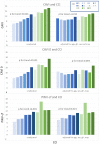The Correlation of Arterial Stiffness Parameters with Aging and Comorbidity Burden
- PMID: 36233629
- PMCID: PMC9572768
- DOI: 10.3390/jcm11195761
The Correlation of Arterial Stiffness Parameters with Aging and Comorbidity Burden
Abstract
The aim of the study was to evaluate the relationships between carotid-femoral pulse wave velocity (PVW-cf), cardio-ankle vascular index (CAVI) and CAVI0 (which is a mathematical elaboration of CAVI, theoretically less dependent on blood pressure), age and comorbidity burden. Furthermore, 183 patients (119 female, mean age 67.5 ± 14.3 years) referred to the Geriatric Ward and Outpatient Clinic at Verona University Hospital were included; demographic, clinical and blood analysis data were collected. Charlson Comorbidity Index (CCI), PVW-cf, CAVI and CAVI 0 were obtained. Significant correlations were found between CAVI, CAVI0, PVW-cf and both age (r = 0.698, r = 0.717, r = 0.410, respectively p < 0.001 for all) and CCI, (r = 0.654; r = 0.658; r = 0.448 respectively and p < 0.001 for all), still significant after adjustment for several variables. In a stepwise multiple regression model, considering several variables, CCI was the only predictor of PWV-cf, whereas age and CCI were significant predictors of both CAVI and CAVI 0. In conclusion, all arterial stiffness indexes are associated with CCI and aging; the latter correlation is more evident for CAVI and CAVI 0 than for PVW-cf. Arterial stiffness parameters can complement the characterization of patients affected by a remarkable comorbidity burden across aging; arterial stiffening might mirror the complexity of these individuals.
Keywords: CAVI; CAVI0; PWV; aging; comorbidity.
Conflict of interest statement
The authors declare no conflict of interest.
Figures
References
-
- Vlachopoulos C., Xaplanteris P., Aboyans V., Brodmann M., Cífková R., Cosentino F., De Carlo M., Gallino A., Landmesser U., Laurent S., et al. The role of vascular biomarkers for primary and secondary prevention. A position paper from the European Society of Cardiology Working Group on peripheral circulation. Endorsed by the Association for Research into Arterial Structure and Physiology (ARTERY) Society. Atherosclerosis. 2015;241:507–532. doi: 10.1016/j.atherosclerosis.2015.05.007. - DOI - PubMed
-
- Asmar R. Principles and usefulness of the cardio-ankle vascular index (CAVI): A new global arterial stiffness index. Eur. Heart J. Suppl. 2017;19:B4–B10. doi: 10.1093/eurheartj/suw058. - DOI
LinkOut - more resources
Full Text Sources


